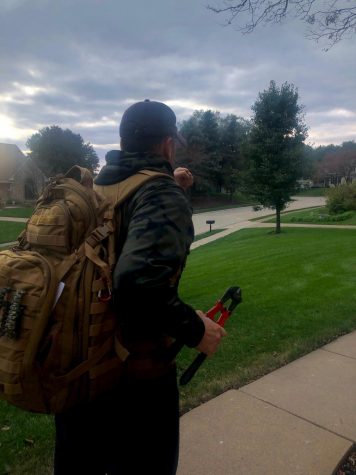
With his prepper bag ready to go, Scott McCartney is prepared for anything that might end the world.
Whether people believe there will be a zombie apocalypse, another world war, or a global pandemic, the number of doomsday bunkers being built is steadily climbing.
Theorists around the globe have been predicting earth’s death date since the very first millennium. Although Earth has stood the test of time, people continue to go to extreme measures to prepare themselves for the worst.
The idea of bunkers has been around for many years, and their nature has improved greatly. Ones of the late 1900s have a reputation for being uncomfortable and prison-like, but the bunkers of today prove themselves to be much more than a protective shield.
While most preppers decide to carry a simple bag filled with “end of the world” essentials, some wealthier preppers go to extensive lengths to have the best protection. “Many of the world’s elite, including hedge fund managers, sports stars and tech executives have chosen to design their own secret shelters to house their families and staff,” said (Elizabeth Stamp) of CNN.
The most popular company supplying these highly demanded bunkers is the global shelter network, Vivos. “Our shelters are considered to be the strongest, most fortified, blast-proof shelters in the world. Once stocked with food, fuel, hygienic supplies, medications and your survival gear, you can easily shelter without returning to the surface for a year or more,” said Vivos.
With this promised prosperity after a global catastrophe, Vivos has marketed their survival shelters as a definite necessity. But has society gone too far? Is there truly a need for these state-of-the-art bunkers?
As far-fetched as these ideas may seem, senior Jack Meyers believes this type of preparation is important to secure the outcome of society’s future. “People preparing for the ‘apocalypse’ are not crazy–they’re actually pretty smart. Eventually the world is somehow going to end, so the idea of having a safe place to go if that happens is a good idea,” said Meyers.
Even with this point of view, Meyers believes that doomsday extremists take prepping too far. So, what leads someone to obsess over the unknown destiny of the world? Psychologically speaking, it is not the most preposterous human behavior studied.
According to a study led by Shmuel Lissek, a neuroscientist at the University of Minnesota, this infatuation with doomsday stems from ancient bias. “The initial response to any hint of alarm is fear. This is the architecture with which we’re built. Over evolutionary history, organisms with a better-safe-than-sorry approach survive,” said Lissek. With these intrinsic responses, it comes as no surprise that people are preparing for the worst.
Not only do preppers enjoy bonding over their shared beliefs of imminent doom, they find reassurance in there commonality. “Knowing when the end will come doesn’t appeal equally to everyone, of course—but for many of us it’s paradoxically a reason to stop worrying,” said Lissek. This concept of an impending apocalypse has formed a community of people who all strive to prepare themselves for the future.
Whether one is focused on getting ready for an asteroid to collide with earth or studying for their next Physics test, preparing for the future remains a constant. And even if the world does not end, investing in a bunker might be the best precautionary step to take.









